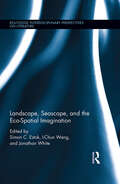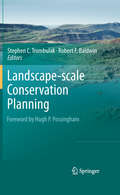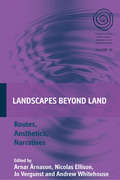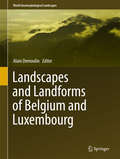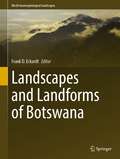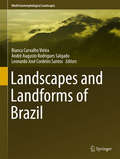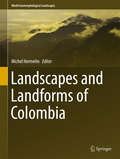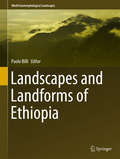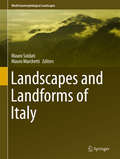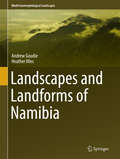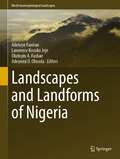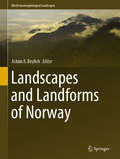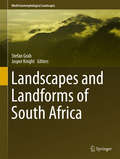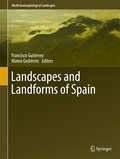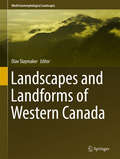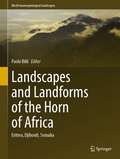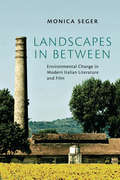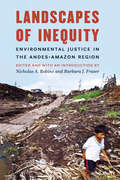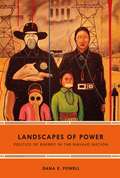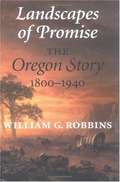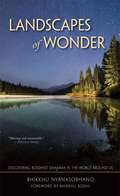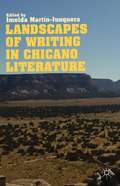- Table View
- List View
Landscape, Seascape, and the Eco-Spatial Imagination (Routledge Interdisciplinary Perspectives on Literature)
by Jonathan White Simon C. Estok I-Chun WangWritten from within the best traditions of ecocritical thought, this book provides a wide-ranging account of the spatial imagination of landscape and seascape in literary and cultural contexts from many regions of the world. It brings together essays by authors writing from within diverse cultural traditions, across historical periods from ancient Egypt to the postcolonial and postmodern present, and touches on an array of divergent theoretical interventions. The volume investigates how our spatial imaginations become "wired," looking at questions about mediation and exploring how various traditions compete for prominence in our spatial imagination. In what ways is personal experience inflected by prevailing cultural traditions of representation and interpretation? Can an individual maintain a unique and distinctive spatial imagination in the face of dominant trends in perception and interpretation? What are the environmental implications of how we see landscape? The book reviews how landscape is at once conceptual and perceptual, illuminating several important themes including the temporality of space, the mediations of place that form the response of an observer of a landscape, and the development of response in any single life from early, partial thoughts to more considered ideas in maturity. Chapters provide suggestive and culturally nuanced propositions from varying points of view on ancient and modern landscapes and seascapes and on how individuals or societies have arranged, conceptualized, or imagined circumambient space. Opening up issues of landscape, seascape, and spatiality, this volume commences a wide-ranging critical discussion that includes various approaches to literature, history and cultural studies. Bringing together research from diverse areas such as ecocriticism, landscape theory, colonial and postcolonial theory, hybridization theory, and East Asian Studies to provide a historicized and global account of our ecospatial imaginations, this book will be useful for scholars of landscape ecology, ecocriticism, physical and social geography, postcolonialism and postcolonial ecologies, comparative literary studies, and East Asian Studies.
Landscape-scale Conservation Planning
by Robert Baldwin Stephen C. TrombulakThis book applies the latest thinking and techniques of systematic conservation planning to the issues that arise in protecting ecosystem pattern and process in human-dominated landscapes such as seascapes, multiple countries and conservation targets.
Landscapes Beyond Land: Routes, Aesthetics, Narratives
by Ellison Árnason Vergunst WhitehouseLand is embedded in a multitude of material and cultural contexts, through which the human experience of landscape emerges. Ethnographers, with their participative methodologies, long-term co-residence, and concern with the quotidian aspects of the places where they work, are well positioned to describe landscapes in this fullest of senses. The contributors explore how landscapes become known primarily through movement and journeying rather than stasis. Working across four continents, they explain how landscapes are constituted and recollected in the stories people tell of their journeys through them, and how, in turn, these stories are embedded in landscaped forms.
Landscapes and Landforms of Belgium and Luxembourg
by Alain DemoulinThis book provides an informative and intriguing overview of the most scenic landscapes of Belgium and Luxembourg. Geodiversity is emphasized, for example the periglacial features in the Hautes Fagnes area, the planation surfaces in the Ardennes and Oesling, and the famous caves of Han/Lesse and Remouchamps. The book's chief goals are to provide the reader with enjoyable and informative descriptions of the selected sites within their regional geographical and geological settings; to offer an up-to-date survey of the evolution of Belgium's and Luxembourg's landscape; and to share additional information on the cultural value of the respective sites wherever appropriate. The book is a richly illustrated reference work that makes accessible for the first time a wealth of information currently scattered among many national and regional journals. It will benefit earth scientists, environmental scientists, tourism geographers and conservationists alike.
Landscapes and Landforms of Botswana (World Geomorphological Landscapes)
by Frank D. EckardtThis volume contains 22 chapters introducing a wide range of semi-arid and geologic landscapes. Botswana, a thinly populated nation, the size of France, is a Southern African keystone country at the heart of the Kalahari, sharing some of the major sub-continental drainage basins such as the Limpopo, Zambezi, Orange, and Okavango with its neighbouring countries. The extensive Kalahari Sand surface has been sculptured by numerous past processes which have produced subtle but regional landforms consisting of extensive dunes and shorelines. Incipient rifting has created the dynamic Okavango and Makgadikgadi fan-basin systems which produces iconic wetlands with a world heritage status. Geological outcrops in particular to the east expose highly denuded basement lithologies which produces numerous inselbergs that are home to a rich archaeological heritage. The book also examines the geomorphology of mineral and water resources which sustain the economy and population and also features dedicated chapters that cover diamondiferous kimberlites, caves, pans, dams, duricrusts and wildlife.Chapter 6 is available open access under a Creative Commons Attribution 4.0 International License via link.springer.com.
Landscapes and Landforms of Brazil
by Bianca Carvalho Vieira André Augusto Rodrigues Salgado Leonardo José Cordeiro SantosThis book presents Brazil as a country of continental dimensions. Its territory has a large variety of rock types, geological structures and climates. The country has a large variety of landscapes, such as the humid plains of the Amazon River, the dry plateaus of the semi-arid region or the subtropical mountains of the southern region. On the coast, some plateaus and mountains, like the Serra do Mar Mountain range, formed a significant barrier front to access the hinterland of Brazil. On the other side of these coastal plateaus and mountains, there is a large collection of other plateaus, mountains, plains and depressions little altered by human interference. Thus, Brazil has a unique variety of different landscapes and extraordinary geomorphological sites. The book invites readers to learn more about the beautiful Brazilian landscapes, their complexity and vastness.
Landscapes and Landforms of Colombia
by Michel HermelinThis book provides an attractive and informative overview of Colombian landscapes and their geological evolution, including comprehensive descriptions of seventeen key selected sites in the country. It provides insight into the geomorphological diversity of Colombian landscapes characterized by climatic and topographic variation. The book covers the essence of the landscapes in the country: coastal features, mud volcanoes, desertic geoforms, snow covered peaks, active volcanoes, deeply incised canyons and subdesertic valleys. It contributes knowledge and understanding into Colombian landscapes and prospects.
Landscapes and Landforms of Ethiopia
by Paolo BilliThis book provides a succinct but comprehensive presentation of key geomorphological locations and topics including information about geomorphological heritage and maps to visit the most important sites. Apart from often being remarkably scenic, landscapes reveal stories that often can be traced back in time tens of million years and include unique events. This is particularly true for Ethiopia where spectacular examples of different landforms are present. Its geomorphology varies from highlands, marked by high volcanoes and incised by deep river gorges, to the rift valley lakes endorheic systems and the below sea level lowlands with characteristic landscapes which are unique in the world. Landscapes and Landforms of Ethiopia highlights all these topics including essential information about geology and tectonic framework, past and present climate, hydrology, geographical regions and long-term geomorphological history. It is a highly informative book, providing insight for readers with an interest in geography and geomorphology.
Landscapes and Landforms of France
by Marie-Françoise André Monique FortThe Landforms and Landscapes of France provides an informative and attractive overview of the most scenic landscapes of France. The geodiversity of France is emphasized, for example the glacial landscapes of the Mont-Blanc Massif, the volcanoes of the French Massif Central, the chalk cliffs and sand dunes of the Atlantic coast, the granitic landscapes of Corsica or the lagoons and coral reefs of French Polynesia. The objectives are to provide the reader with an enjoyable and informative description of the selected sites within their regional geographical and geological settings; to offer an up-to-date survey of the evolution of France's landscape; and to give additional information on the cultural value of the selected sites wherever appropriate (prehistoric paintings, legends related to sites, famous vineyards, etc.). The book is a richly illustrated reference work that makes accessible for the first time a wealth of information currently scattered among many national and regional journals. It will be of benefit to earth scientists, environmental scientists, tourism geographers and conservationists
Landscapes and Landforms of India
by Vishwas S. KaleThe proposed monograph on 'Geomorphological Landscapes of India' will aim to describe and explain in simple words the geomorphological characteristics and the origin of the above-mentioned landforms and landscapes. The proposed monograph will provide the background information about the geology, climate and tectonic framework of the Indian region, as well as cover Indian climates of the present and the past. It will mainly cover the four main morphotectonic regions of India and about 15-20 distinct landforms of the Indian region as well as the major geomorphosites in India.
Landscapes and Landforms of Italy
by Mauro Soldati Mauro MarchettiThe book deals with the most striking landscapes and landforms of Italy. Attention is given to landform diversity and landscape evolution through time which has been controlled by very diverse geological conditions and dramatic climate changes that have characterized the Italian peninsula and islands since the end of the last glaciation. In addition, various examples of human impact on the landscape are presented. Landscapes and Landforms of Italy contains more than thirty case studies of a multitude of Italian geographical landmarks. The topics and sites described in this book range from the Alpine glaciers to the Etna and Vesuvius volcanoes, taking into account the most representative fluvial, coastal, gravity-induced, karst and structural landscapes of the country. Chapters on the geomorphological landmarks of the cities of Rome and Venice are also included. The book provides the readers with the opportunity to explore the variety of Italian landscapes and landforms through informative texts illustrated with several color maps and photos. This book will be relevant to scientists, scholars and any readers interested in geology, physical geography, geomorphology, landscape tourism, geoheritage and environmental protection.
Landscapes and Landforms of Namibia
by Andrew Goudie Heather VilesThe landscapes of Namibia are of world-class quality in beauty, diversity and interest. This book provides the first ever overview of the most important of these landscapes, explains why they look as they do, and evaluates why they are of note. Writing from a geomorphological perspective, the authors introduce the key processes and controls which influence landscape and landform development in Namibia. Geological and tectonic background, climate now and in the past, vegetation and animals (including humans) are all identified as crucial factors influencing the landscape of Namibia today. The book presents twenty one richly-illustrated case studies of the most significant landscapes of Namibia, ranging from the iconic Etosha Pan at the heart of the biggest wildlife conservation area in the north, to the famous dunes and ephemeral river at Sossus Vlei in the heart of the Namib desert. Each case study also contains a full list of the key references to the scientific work on that landscape. The authors provide an assessment of the current state of conservation of these landscapes, and their importance to tourism. The book is recommended reading for anyone with a professional or amateur interest in the spectacular and intriguing landscapes of this part of southern Africa. It provides a useful handbook for those travelling around Namibia, and an invaluable reference guide for those interested in how landscapes develop and change.
Landscapes and Landforms of Nigeria (World Geomorphological Landscapes)
by Adetoye Faniran Lawrence Kosoko Jeje Olutoyin A. Fashae Adeyemi O. OlusolaThe book deals with the most striking landscapes and landforms of Nigeria. Attention is paid to the diversity of geomorphic features found in the country, from the coast to the extreme north, approached geographically at the national, regional and local scales, with a view to highlight the combined influence of geological, climatic, biotic and anthropogenic influences, as well as geoheritage potentials. The topics and sites described range from the mainly depositional coastal lagoons and inlets, the most prominent of which is the oil rich Niger Delta, characterized by the mangrove and rain forest, both of which have been seriously modified by human impact; through the coastal lowlands and associated hill country, with derived, deciduous and dry forest vegetation; the very prominent Niger/Benue Trough and associated features; the savanna-semi desert covered high plains of the north and the Chad Basin, each of which features spectacular landscapes and landforms, including human-made forms such as cities and cityscapes. The book provides the readers with the opportunity to explore the variety of Nigerian landscapes and landforms through informative texts illustrated with color maps and photos: it will be relevant to scientists/scholars as well as others interested in the geology, physical geography, geomorphology, landscape, tourism and other geoheritage-related information about the country.
Landscapes and Landforms of Norway (World Geomorphological Landscapes)
by Achim A. BeylichThis book discusses the striking geomorphological landscapes of mainland Norway. As part of the Springer book series on World Geomorphological Landscapes, it outlines the nature and diversity of Norway's geomorphological landscapes and examines the geological background and the drivers of landscape evolution. It also features numerous case studies describing the most striking sites, and offers insights into the status and value of geoheritage and geoconservation in the country.Providing readers with an opportunity to explore the variety of Norwegian landscapes and landforms through informative texts richly illustrated with color maps and photos, the book will appeal to scientists, scholars and any readers interested in geology, physical geography, geomorphology, landscape tourism, geoheritage and environmental protection.
Landscapes and Landforms of Slovakia (World Geomorphological Landscapes)
by Milan Lehotský Martin BoltižiarLandscapes and Landforms of the Slovakia provides an attractive physiographical overview of the most prominent landscapes of Slovakia and the distinctive landforms associated with them. It describes the main driving factors leading to their evolution and importance for geoconservation and geotourism.The richly illustrated book provides the reader with enjoyable and informative descriptions of the selected sites within their regional geographical and geological settings range from the Tatras Mts. with glacially shaped relief as the highest region in the Carpahians to caves and lowlands taking into account fluvial, gravity-induced, karst and structural landscapes of the Slovakia.The book is organized in 3 parts: a) Introduction, which presents a general framework of the physical geography of Slovakia, b) Geomorphological landscapes, presenting papers dealing with key geomorphological areas, resp. landforms, c) Geoheritage and landscape protection, providing an updated vision on the geomorphological/geological heritage sites and landscape protection policy in Slovakia.The book will be relevant to scientists, scholars and any readers interested in geomorphology, geology, physical geography, geoheritage, landscape tourism and environmental protection. It can be also used for undergraduate and graduate courses in Earth and environmental sciences.
Landscapes and Landforms of South Africa
by Jasper Knight Stefan GrabThis book presents a beautifully illustrated overview of the most prominent landscapes of South Africa and the distinctive landforms associated with them. It describes the processes, origins and the environmental significance of those landscapes, including their relationships to human activity of the past and present. The sites described in this book include, amongst others, the Blyde River Canyon, Augrabies Falls, Kruger National Park, Kalahari desert landscapes, the Great Escarpment, Sterkfontein caves and karst system, Table Mountain, Cape winelands, coastal dunes, rocky coasts, Boer War battlefield sites, and Vredefort impact structure. Landscapes and Landforms of South Africa provides a new perspective on South Africa's scenic landscapes by considering their diversity, long and short term histories, and importance for geoconservation and geotourism. This book will be relevant to those interested in the geology, physical geography and history of South Africa, climate change and landscape tourism.
Landscapes and Landforms of Spain
by Francisco Gutiérrez Mateo GutiérrezThe Landscapes and Landforms of Spain provides an informative and inviting overview of the geology and geomorphology of Spain. It incorporates a diverse range of topics, ranging from the fiery landscapes of the Canary Islands and its volcanic formations to the glacial scenery of the Pyrenees. The book devotes attention to granite landforms, karst terrains, coastal dunes and marshes, as well as to heritage and conservation, with the objective of offering the reader a comprehensive insight into the Spanish geological setting. The book presents readers with the opportunity to explore Spanish landforms in detail through its highly illustrated pages and maps, making this an appealing text on the subject field.
Landscapes and Landforms of Western Canada
by Olav SlaymakerThis is the only book to focus on the geomorphological landscapes of Canada West. It outlines the little-appreciated diversity of Canada's landscapes, and the nature of the geomorphological landscape, which deserves wider publicity. Three of the most important geomorphological facts related to Canada are that 90% of its total area emerged from ice-sheet cover relatively recently, from a geological perspective; permafrost underlies 50% of its landmass and the country enjoys the benefits of having three oceans as its borders: the Arctic, Pacific and Atlantic oceans. Canada West is a land of extreme contrasts -- from the rugged Cordillera to the wide open spaces of the Prairies; from the humid west-coast forests to the semi-desert in the interior of British Columbia and from the vast Mackenzie river system of the to small, steep, cascading streams on Vancouver Island. The thickest Canadian permafrost is found in the Yukon and extensive areas of the Cordillera are underlain by sporadic permafrost side-by-side with the never-glaciated plateaus of the Yukon. One of the curiosities of Canada West is the presence of volcanic landforms, extruded through the ice cover of the late Pleistocene and Holocene epochs, which have also left a strong imprint on the landscape. The Mackenzie and Fraser deltas provide the contrast of large river deltas, debouching respectively into the Arctic and Pacific oceans.
Landscapes and Landforms of the Horn of Africa: Eritrea, Djibouti, Somalia (World Geomorphological Landscapes)
by Paolo BilliThis book focuses on regions for which until now the geomorphology was very poorly studied and relatively unknown. Nevertheless, the landforms and landscapes of the Horn of Africa are highly attractive, diverse and in a few cases unique, since they span very different environments, from highland plateaus and mountains to lowlands (even below sea level) and coastlines with a high degree of diversity and from monsoon to arid climate conditions. The main topics addressed in the book include the links between the geological evolution and the current large scale geomorphology of the Horn of Africa; the large differences between the highlands and lowlands climate, river hydrology and their variation through time within a climate change perspective. This part of the world was home of the very first hominids. The landscape in which they lived and evolved throughout the Pleistocene is described in comparison with the arid and inhospitable, though immensely scenic, environment of today. Perennial and ephemeral rivers with very different morphology, processes, and hydrology drain the area, and, in combination with the past and recent uplift, substantially contributed to provide the region with peculiar landscapes and landforms. Long lasting weathering and erosion processes result in a typical inselberg landscape such as the Bur region, or the currently exposed flatland of old peneplain surfaces. Their changes through time, induced by both natural and anthropogenic factors, are addressed by a couple of case studies. Though the region has few inhabitants, they had to struggle to find their livelihood in a land that offers poor resources. This resulted in landscape change and land degradation. Examples of human impact on the landscape are presented at different scales. This book provides readers interested in geography and geomorphology with essential scientific and educational information on the Landscapes and Landforms of Eritrea, Djibouti and Somalia through simple, though scientifically, rigorous texts illustrated with several color maps and photos. One main prerogative of this book is therefore to give an insight into a region of the world where, for geographical and historical constraints, geomorphological investigation was very limited, thus enriching its intrinsic informative value.
Landscapes in Between
by Monica SegerSince its economic boom in the late 1950s, Italy has grappled with the environmental legacy of rapid industrial growth and haphazard urban planning. One notable effect is a preponderance of interstitial landscapes such as abandoned fields, polluted riverbanks, and makeshift urban gardens. Landscapes in Between analyses authors and filmmakers - Italo Calvino, Pier Paolo Pasolini, Gianni Celati, Simona Vinci, and the duo Daniele Ciprì and Franco Maresco - who turn to these spaces as productive models for coming to terms with the modified natural environment.Considering the ways in which sixty years' worth of Italian literary and cinematic representations engage in the ongoing dialogue between nature and culture, Monica Seger contributes to the transnational expansion of environmental humanities. Her book also introduces an ecocritical framework to Italian studies in English. Rejecting a stark dichotomy between human construction and unspoilt nature, Landscapes in Between will be of interest to all those studying the fraught relationship between humanity and environment.
Landscapes of Inequity: Environmental Justice in the Andes-Amazon Region
by Nicholas A. Robins Barbara J. FraserThe natural wealth of the Amazon and Andes has long attracted fortune seekers, from explorers, farmers, and gold panners to multimillion-dollar mining, oil and gas, and timber operations. Modern demands for commodities have given rise to new development schemes, including hydroelectric dams, open cast mines, and industrial agricultural operations. The history of human habitation in this region is intimately tied to its rich biodiversity, and the Amazon basin is home to scores of indigenous groups, many of whom have populations so small that their cultural and physical survival is endangered.Landscapes of Inequity explores the debate over rights to and use of resources and addresses fundamental questions that inform the debate in the western Amazon basin, from the Andes Mountains to the tropical lowlands. Beginning with an examination of the divergent conceptual interpretations of environmental justice, the volume explores the issue from two interlocking perspectives: of indigenous peoples and of economic development in a global economy. The volume concludes by examining the efficacy of laws and policies concerning the environment in the region, the viability and range of judicial recourse, and future directions in the field of environmental justice.
Landscapes of Power: Politics of Energy in the Navajo Nation
by Dana E. PowellIn Landscapes of Power Dana E. Powell examines the rise and fall of the controversial Desert Rock Power Plant initiative in New Mexico to trace the political conflicts surrounding Native sovereignty and contemporary energy development on Navajo (Diné) Nation land. Powell's historical and ethnographic account shows how the coal-fired power plant project's defeat provided the basis for redefining the legacies of colonialism, mineral extraction, and environmentalism. Examining the labor of activists, artists, politicians, elders, technicians, and others, Powell emphasizes the generative potential of Navajo resistance to articulate a vision of autonomy in the face of twenty-first-century colonial conditions. Ultimately, Powell situates local Navajo struggles over energy technology and infrastructure within broader sociocultural life, debates over global climate change, and tribal, federal, and global politics of extraction.
Landscapes of Promise: The Oregon Story, 1800-1940
by William G. Robbins William CrononBefore the first white trappers reached the Oregon country in the late 18th century, Native Americans had already had a profound impact on the landscape by regularly burning forest undergrowth to open grazing land for elk and deer. Europeans and Americans, however, viewed the land as a series of commercial opportunities and exploited resources they believed to be unlimited. Drawing upon newspaper accounts, journals, and a host of other primary sources, the author explores human activity in Oregon and the attitudes which affected it.
Landscapes of Wonder
by Bhikkhu Bodhi Bhikkhu Nyanasobhano"To most of us there have come exceptional, unworldly moments, like unsuspected deeps in a stream, when we fell through appearances - fell through ourselves - into an intuition of majesty and wonder." - Bhikkhu Nyanasobhano in Landscapes of Wonder Landscapes of Wonder deftly transports the spirit of Buddhist contemplation off the cushion and into the natural world. With a lyricism and spiritual immediacy reminiscent of Thoreau and Emerson, in eighteen meditational essays Bhikkhu Nyanasobhano considers Buddhist themes through the prism of nature. The reflections captured in these satisfying literary explorations will appeal to all who appreciate contemplation of the natural world and our place in it.
Landscapes of Writing in Chicano Literature
by Imelda Martín-JunqueraAdding nuance to a global debate, esteemed scholars from Europe and North and Latin America portray the attempts in Chicano literature to provide answers to the environmental crisis. Diverse ecocritical perspectives add new meaning to the novels, short stories, drama, poetry, films, and documentaries analyzed in this timely and engaged collection.
